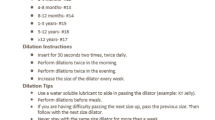Abstract
Background
In order to prevent stricture of the neoanus after surgical correction, regular dilatation is recommended. There is a lack of knowledge about the performance of anal dilatation and the occurrence of pain. The aim of our investigation was to describe the practice of dilatation and to identify possible risk factors for painful procedures.
Methods
Congenital Uro-Rectal Malformations Network is a German interdisciplinary multicenter research network. With standard questionnaires, physicians interviewed 243 patients and/or their parents at home, additional 103 patients born since 2009 were assessed through their treating physicians.
Results
In total, 88 % of the patients received dilatations. Treatment lasted for 7 months in median (range 1–156 months), until the age of 13 months (range 1–171 months). In 69 % painful dilatation was reported; without a significant differences in age or gender. In 32 % bleeding was reported. In 30 % at least one dilatation was performed under general anesthesia. In 11 % some kind of analgesia was used. Type of fistula, dilatations lasting longer than 10 months and Hegar size above 15 were relevant factors for experience of pain. There were about 16 % postoperative strictures of the neoanus, without reported differences in dilatation procedures; but there was a relation to type of malformation.
Conclusion
Considering the high number of painful treatments, predictors for painful dilatations should be further clarified through standardized documentation and prospective evaluation in order to improve follow-up.
Similar content being viewed by others
References
Jenetzky E (2007) Prevalence estimation of anorectal malformations using German diagnosis related groups system. Pediatr Surg Int 23:1161–1165
Peña A (1990) Atlas of surgical management of anorectal malformations. Postop care, complications and results, Chap 7. Springer, New York, p 92
Temple SJ, Shawyer A, Langer JC (2012) Is daily dilatation by parents necessary after surgery for Hirschsprung disease and anorectal malformations? J Pediatr Surg 47:209–212
Diseth TH, Egeland T, Emblem R (1998) Effects of anal invasive treatment and incontinence on mental health and psychosocial functioning of adolescents with hirschsprung′s disease and low anorectal anomalies. J Pediatr Surg 33:468–475
Diseth TH, Emblem R, Solbraa IB, Vandvik IH (1994) A psychosocial follow- up of ten adolescents with low anorectal malformations. Acta Paediatr 83:216–221
Diseth TH (2006) Dissociation following traumatic medical treatment procedures in childhood: a longitudinal follow- up. Dev Psychopathol 18:233–251
Märzheuser S, Jenetzky E, Zwink N, Reutter H, Bartels E, Grasshoff-Derr S, Holland-Cunz S, Hosie S, Schmiedeke E, Schwarzer N, Spychalski N, Goetz G, Schmidt D (2011) German network for congenital uro-rectal malformations: first evaluation and interpretation of postoperative urological complications in anorectal malformations. Pediatr Surg Int 27:1085–1089
Menon P, Rao N (2007) Primary anorectoplasty in females with common anorectal malformations without colostomy. J Pediatr Surg 42:1103–1106
El Haddad M, Corkery JJ (1985) The anus of the newborn. Pediatr 76:927–928
Büttiker V (1994) Anal caliber and anus position: an investigation of 157 newborn to determine norm values. Doctoral thesis, Zurich
Acknowledgments
The authors are members of the “Network for the Systematic Investigation of the Molecular Causes, Clinical Implications, and Psychosocial Outcome of Congenital Uro-Rectal Malformations (CURE-Net)” which was initiated 2009–2012 by a Research Grant (No. 01GM08107) from the German Federal Ministry of Education and Research (Bundesministerium für Bildung und Forschung, BMBF).
Author information
Authors and Affiliations
Corresponding author
Additional information
E. Jenetzky and S. Reckin have equally contributed to this work.
Rights and permissions
About this article
Cite this article
Jenetzky, E., Reckin, S., Schmiedeke, E. et al. Practice of dilatation after surgical correction in anorectal malformations. Pediatr Surg Int 28, 1095–1099 (2012). https://doi.org/10.1007/s00383-012-3169-4
Accepted:
Published:
Issue Date:
DOI: https://doi.org/10.1007/s00383-012-3169-4




